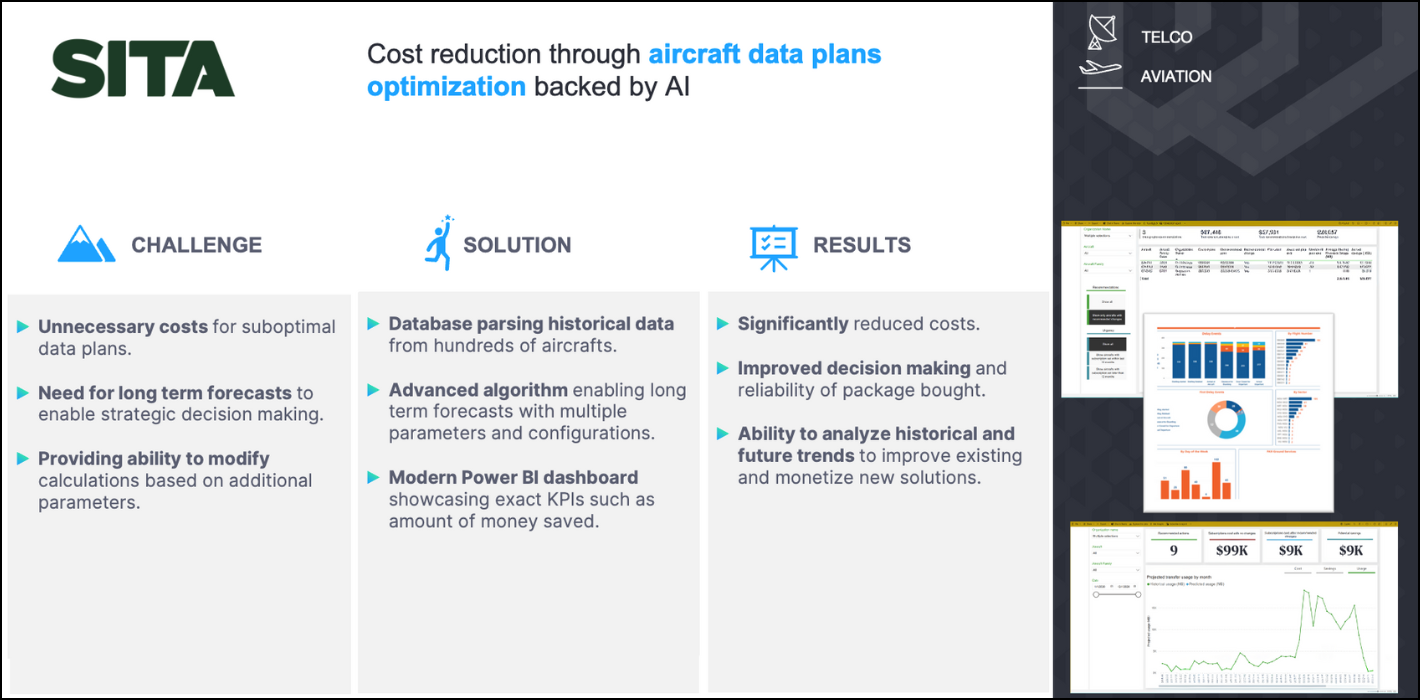The client
SITA for Aircraft, the leading global aviation IT provider, enables digital transformation for over 400 customers across 18,000 commercial aircraft, with over 90 air navigation service providers. SITA ensures the highest standard of flight operations for 90% of the global airline business, providing services such as digital day of operations, aircraft data management, and unified aircraft communications.

The problem
As aircraft became digitalized, flying data centers, SITA decided to harness full potential of the Connected Aircraft as an answer to technological shift in aircraft industry. As a client they needed a complete, efficient solution to parse, analyze and monetize data from 50+ services provided to more than 400 customers in global aircraft industry.
The challenge
SITA provides airlines with IT infrastructure, part of this is enabling aircraft to access the internet during flight. To that end SBB plans, a yearly subscription for data volume packages, were used. However, the initial subscription selection for airplanes was not properly tailored; often the subscription data volume included either an insufficient or excessive amount volume. This led to higher costs, forced additional subscriptions and lower reliability of the service.
To help our client we had to consider:
- Prediction method required adjustment to dynamic nature of data including planes with anomalous data.
- Predicting exact amount of money saved after changing data plan to enable better decision making.
- Providing ability to “what-if” analysis by quickly recalculating relevant KPIs based on custom input criteria.
The solution
BitPeak goal was to analyze cockpit SBB plans to provide recommendations of the most efficient data plan for a particular aircraft from a wide selection of options. We achieved that by gathering real, historical aircraft usage for every aircraft on each of the hundreds of airlines that SITA partnered with. Afterwards we used machine learning to assign optimal SBB plans based on predicted usage and plan details such as volume limits, price, possibility of sharing plan with other aircraft, as well as bandwidth allowance. Finally, we presented recommendations and calculated potential savings. All in the form of an easy-to-use dashboard.
To realize our goal, we used Azure cloud technologies, including:
- Databricks platform: for data analysis with Databricks Notebooks
- Azure Data Factory: for calculation parameters and configuration management
- SQL Managed Instance: for data aggregation and loading
- Power BI: for data visualization
- Source data is taken from dedicated Data Model stored in Managed Instance
- We’ve used Databricks Notebooks to process gathered data. The solution predicts usage volume for upcoming months and assigns the best plan for each aircraft based on 23 parameters, including contractual and technical limits of each plan, managed with Azure Data Factory.
- The results are saved in Delta parquet and presented via Power BI reports. The report itself uses additional, more complex data modelling techniques which enable viewing the data in multiple dimensions. The report presents recommendations to the user with a convenient data export possibility.
- Lastly, an additional workflow is implemented to verify the recommendation once real usage for given aircraft is gathered. The comparison between predicted and real data volume is calculated and real savings from recommended changes verified.
Benefits:
Strategy
Using our solution we were able to augment client’s data plan strategy. We analyzed 200 aircrafts, based on multiple characteristics to create optimal data plan models depending on parameters such as the route, destination, amount of passengers and more. This resulted in not only valuable information for future analytics but also 120 recommended plan changes!
Management
BitPeak’s aircraft data plan optimization allowed for better management of data plan purchases, resulting in drastically reduced amount of plans overuse or underutilization. This in turn led to higher predictability of the operations as well as 30% lower data plan costs and higher margins due to 400 000$+ Yearly savings.
Customers
Thanks to the predictive power of our solution, our client was able to increase the level of quality of data-based services accessible to passengers, increasing their satisfaction, resulting in more services sold and higher customer retention.


 (+48) 508 425 378
(+48) 508 425 378 office@bitpeak.pl
office@bitpeak.pl








